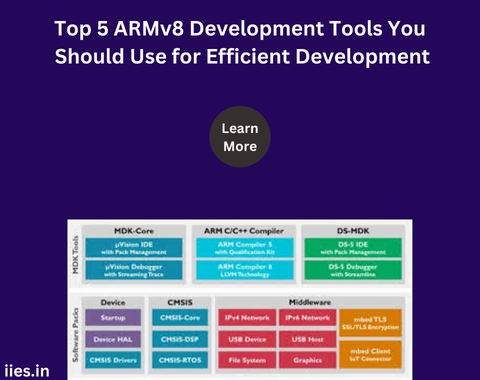
The ARMv8 architecture has become a cornerstone in modern computing, providing the foundation for high-performance processors in smartphones, servers, and embedded systems. With its 64-bit capability, ARMv8 offers increased processing power, efficiency, and the ability to handle complex computing tasks. To harness the full potential of ARM v8, developers need robust development tools that offer comprehensive support, efficient workflows, and advanced debugging capabilities. In this article, we’ll explore the top 5 ARMv8 development tools that every developer should consider using.
Overview: ARM Development Studio is a complete suite of tools designed specifically for ARM-based processors, including the ARMv8 architecture. It provides an integrated environment that supports all stages of software development, from code writing to debugging and optimization. ARM Development Studio is particularly valuable for developers working on embedded systems and applications that require precise control over hardware resources.
Key Features:
Why You Should Use It: ARM Development Studio is an all-in-one solution for ARMv8 development. Its comprehensive set of tools and features ensures that developers have everything they need to create, debug, and optimize software for ARMv8 processors, making it an essential tool for anyone working with this architecture.
Overview: The GNU Compiler Collection (GCC) is a widely used open-source compiler system that supports a variety of programming languages, including C and C++. GCC for ARM is a specialized version of GCC tailored for ARM architectures, including ARMv8. This compiler is known for its reliability, extensive community support, and ability to generate efficient machine code.
Key Features:
Why You Should Use It: GCC for ARM is a powerful and reliable compiler that has been battle-tested in numerous projects. Its open-source nature, coupled with its strong optimization capabilities, makes it an excellent choice for ARMv8 developers looking for a cost-effective and efficient toolchain.
Overview: Keil MDK-ARM, developed by ARM, is a development environment specifically designed for ARM microcontrollers, including those based on the ARMv8 architecture. It is widely used in embedded systems development, offering a robust set of tools tailored for low-level programming and hardware interaction.
Key Features:
Why You Should Use It: Keil MDK-ARM is an industry-standard tool for embedded systems development. Its focus on ARM microcontrollers, combined with its powerful debugging and optimization features, makes it an ideal choice for developers working on ARMv8-based embedded applications.
Overview: The Linaro Toolchain is a set of open-source tools optimized for ARM architectures, including ARMv8. Linaro is a collaborative engineering organization focused on improving open-source software for ARM processors, and its toolchain is widely used in both commercial and open-source projects.
Key Features:
Why You Should Use It: The Linaro Toolchain offers a robust and regularly updated set of tools that are specifically optimized for ARM processors. Its strong open-source community and focus on ARM make it a great choice for developers looking for a reliable and efficient toolchain for ARMv8 development.
Overview: DS-5 Development Studio, now part of ARM Development Studio, was a professional software development environment for ARM processors. It provided a comprehensive set of tools for developing, debugging, and optimizing software on ARM architectures, including ARMv8.
Key Features:
Why You Should Use It: Although DS-5 has been integrated into ARM Development Studio, it remains an important part of ARM’s development ecosystem. If you are using ARM Development Studio, you are already benefiting from the features and capabilities that made DS-5 a popular choice among ARM developers.
Developing for the ARMv8 architecture requires the right set of tools to ensure efficient and effective development. The tools highlighted in this article—ARM Development Studio, GCC for ARM, Keil MDK-ARM, Linaro Toolchain, and DS-5 Development Studio—offer a range of features that cater to different aspects of ARMv8 development, from writing and compiling code to debugging and performance analysis. By choosing the right tool for your specific needs, you can streamline your development process and take full advantage of the powerful capabilities of ARMv8 processors.
Indian Institute of Embedded Systems – IIES